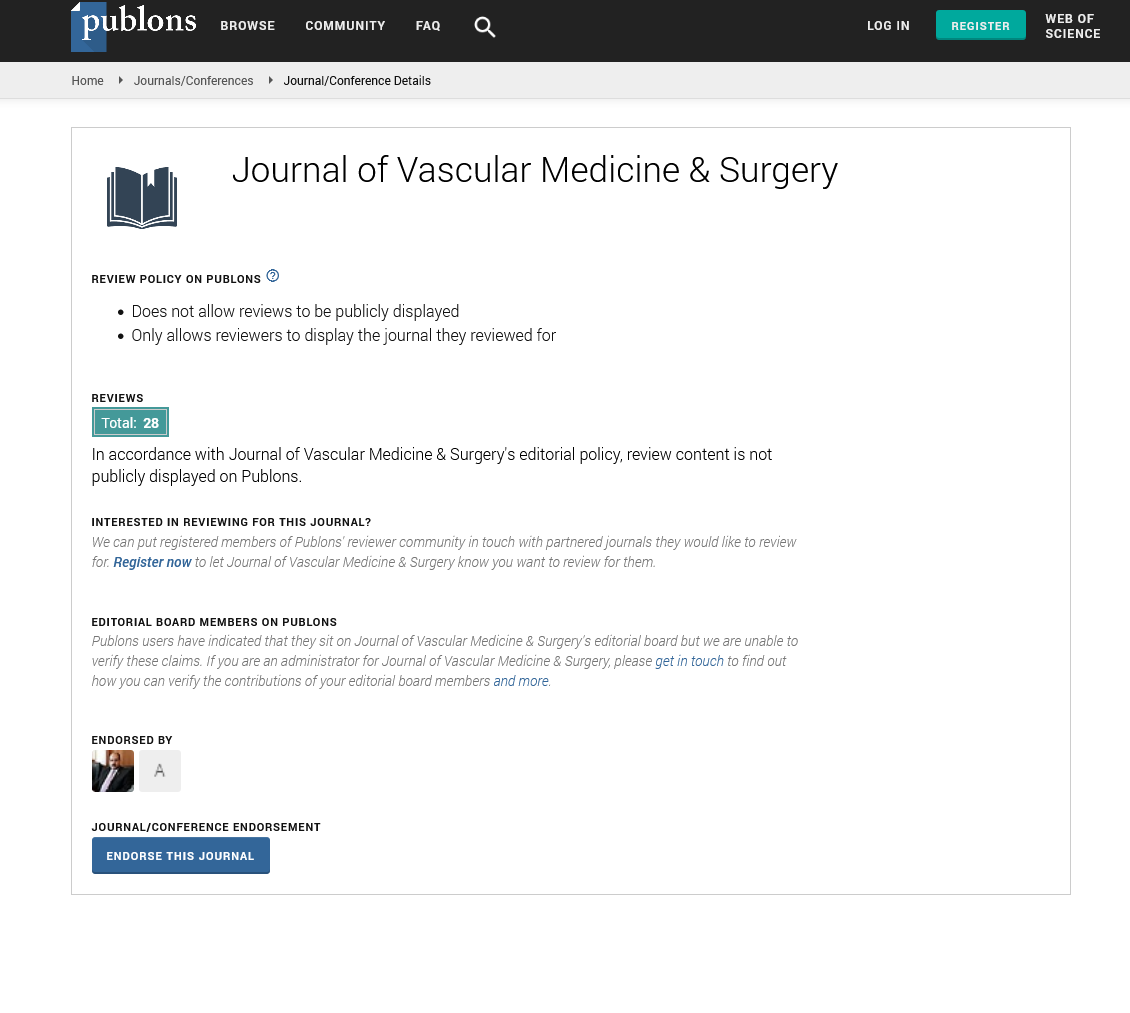Indexed In
- Open J Gate
- Academic Keys
- RefSeek
- Hamdard University
- EBSCO A-Z
- OCLC- WorldCat
- Publons
- Euro Pub
- Google Scholar
- SHERPA ROMEO
Useful Links
Share This Page
Journal Flyer

Open Access Journals
- Agri and Aquaculture
- Biochemistry
- Bioinformatics & Systems Biology
- Business & Management
- Chemistry
- Clinical Sciences
- Engineering
- Food & Nutrition
- General Science
- Genetics & Molecular Biology
- Immunology & Microbiology
- Medical Sciences
- Neuroscience & Psychology
- Nursing & Health Care
- Pharmaceutical Sciences
Short Communication - (2022) Volume 10, Issue 3
Management Strategy of Left Atrial Appendage Closure Device Embolization
Anggia Chairuddin Lubis and Dian Andina Munawar2Department of Medicine, University of Sumatera Utara, Sumatera Utara, Indonesia
3Department of Cardiology and Vascular Medicine, University of Indonesia, Jakarta, Indonesia
Received: 07-Apr-2022, Manuscript No. JVMS-22-16066; Editor assigned: 13-Apr-2022, Pre QC No. JVMS-22-16066(PQ); Reviewed: 26-Apr-2022, QC No. JVMS-22-16066; Revised: 28-Apr-2022, Manuscript No. JVMS-22-16066(R); Published: 07-May-2022, DOI: 10.35841/2329-6925.22.10.449
Description
Device embolization is a well-known complication of Left Atrial Appendage Closure (LAAC) procedures, with incidence rate of less than 2% reported in the real-world registry. Most cases of the embolization occur acutely after the procedure: during the procedure, the same day or the day after procedure [1-4]. We have previously reported a case of acute dislodgement of LAAC device and managed with a contemporary approach in the retrieval strategy [4]. Either percutaneous or surgical retrieval strategy offers its own advantages and disadvantages. Percutaneous retrieval strategy is more favorable in most LAAC embolization, and yields high successful rate. Device embolization had a 94% chance of being snared percutaneously. However, what is clear that irrespective of these techniques that if a LAAC device becomes entangled in the mitral valve, surgical removal is the safest way to proceed. The endocardium and pliable leaflets are at high risk of perforation and damaged by the fixation anchors [5]. A better understanding of the mechanism and the key of percutaneous retrieval strategy is essential for prevention and management of LAAC device embolization.
Mechanisms of device embolization
Several mechanisms of device embolization have been identified and categorized based on timing: pre-procedure, during implantation or after procedure. Pre-procedure evaluation underlines the importance of anatomical assessment prior to procedure, including shallow LAA landing zone. In this case, the use of thinner LAAC devices are potentially more suitable, otherwise percutaneous LAA ligation should be considered. During implantation procedure, device sizing and positioning are very important to analyze, including device apposition assessment and vigorous wiggle test. Undersize or oversize device also increase the risk of embolization. Finally, the risk for embolization remains increased after implantation. Conversion from Atrial Fibrillation (AF) to sinus rhythm escalates the risk of embolization. In addition, although simultaneous AF ablation and LAAC in a single procedure has been proven safe in some reports, however it may also bring additional risk [4,6-10].
Location of LAAC device embolization
The anatomical locations for LAAC device embolization can be in the Left Atrium (LA), Left Ventricle (LV) and Aorta (Ao). The first two were more common; however the retrieval strategy is somehow different. Retrieval from the LV chamber is the most complex approach, mostly due to the presence of mitral apparatus and surrounding critical structures. Extraction by percutaneous approach is considered high risk of damaging mitral or aortic valves.
Stepwise approach of percutaneous retrieval of embolized LAAC device:
1. Device stabilization
Acute valvular damages and acute heart failure has been reported due to migrating LAAC devices. Irrespective to the retrieval strategy, stabilizing the dislodged device is an important first step. The use of snare and steerable-sheath has been reported to wrap and stabilize the dislodged device [6,7].
2. Is the LAAC device in the LV?
The complexities of LV structures made percutaneous retrieval strategy very difficult and put surgical strategy as first option. However percutaneous approach considered as first option in other embolization locations.
3. Percutaneous extraction tools
Regular snare is the most popular tool to capture the LAAC device. However several modifications have been used; modified snare or grasping device has been proven effective in several scenarios. Each tools has their own advantages and disadvantages [4,11].
4. Safe escape route
The best way to do the extraction safely is to pull the whole device into the sheath, and take all assemblies out as a unit. However, in most situations it can be difficult after the device has been fully deployed. The second option is to shrink the device, pull most part of the device into the sheath and leave some other part outside during the pull back. Finally, venous access can be handled with regular care, however care for arterial access and large sheath should be managed gently. Arterial access can be managed with multiple vascular closure devices or by surgical closure.
Conclusion
In conclusion, prevention of LAAC embolization can be optimized with better understanding of identified mechanisms. Moreover, step-by-step details in percutaneous retrieval strategy are important in preventing further complication and improving success rate.
REFERENCES
- Boersma LV, Ince H, Kische S, Pokushalov E, Schmitz T, Schmidt B, et al. Efficacy and safety of left atrial appendage closure with watchman in patients with or without contraindication to oral anticoagulation: 1-Year follow-up outcome data of the evolution trial. Heart Rhythm. 2017;14:1302-1308.
[Crossref] [Google Scholar] [Pubmed]
- Stollberger C, Schneider B, Finsterer J. Serious complications from dislocation of a Watchman left atrial appendage occluder. J Cardiovasc Electrophysiol. 2007;18:880-881.
[Crossref] [Google Scholar] [Pubmed]
- Aminian A, Lalmand J, Tzikas A, Budts W, Benit E, Kefer J. Embolization of left atrial appendage closure devices: A systematic review of cases reported with the watchman device and the amplatzer cardiac plug. Catheter Cardiovasc Interv. 2015;86:128-135.
[Crossref] [Google Scholar] [Pubmed]
- Lubis AC, Iqbal M, Munawar DA, Hartono B, Munawar M. A simple percutaneous retrieval technique for an embolized watchman left atrial appendage closure device in the thoracic aorta using a homemade snare. Int Heart J. 2021;62:1153-1155.
[Crossref] [Google Scholar] [Pubmed]
- Murtaza G, Dar T, Akella K, Yarlagadda B, Gloekler S, Meier B, et al. Left atrial appendage occlusion device embolization (the laaode study): understanding the timing and clinical consequences from a worldwide experience. J Atr Fibrillation. 2021;13:2516.
[Crossref] [Google Scholar] [Pubmed]
- Deng H, Liao H, Liu Y, Chen S, Xue Y, Zhan X, et al. Acute heart failure caused by dislocation of a watchman left atrial appendage occluder. JACC Cardiovasc Interv. 2016;9:e97-99.
[Crossref] [Google Scholar] [Pubmed]
- Spilias N, Kochar A, Patel J, Saliba W, Kapadia S. Percutaneous retrieval of a watchman device from the left ventricle using a transarterial approach. JACC Case Rep. 2019;1:876-883.
[Crossref] [Google Scholar] [Pubmed]
- Vroomen M, Maesen B, Luermans JG, Crijns HJ, Maessen JG, La Meir M, et al. Left atrial appendage management with the watchman device during hybrid ablation of atrial fibrillation. J Interv Cardiol. 2019;2019:4525084.
[Crossref] [Google Scholar] [Pubmed]
- Swaans MJ, Post MC, Rensing BJ, Boersma LV. Ablation for atrial fibrillation in combination with left atrial appendage closure: First results of a feasibility study. J Am Heart Assoc. 2012;1:e002212.
[Crossref] [Google Scholar] [Pubmed]
- Walker DT, Phillips KP. Left atrial catheter ablation subsequent to Watchman(R) left atrial appendage device implantation: a single centre experience. Europace. 2015;17:1402-1406.
[Crossref] [Google Scholar] [Pubmed]
- Turagam MK, Neuzil P, Dukkipati SR, Petru J, Skalsky I, Weiner MM, et al. Percutaneous retrieval of left atrial appendage closure devices with an endoscopic grasping tool. JACC Clin Electrophysiol. 2020;6:404-413.
[Crossref] [Google Scholar] [Pubmed]
Citation: Lubis AC, Munawar DA, Munawar M (2022) Management Strategy of Left Atrial Appendage Closure Device Embolization. J Vasc Surg. 10:449.
Copyright: © 2022 Lubis AC, et al. This is an open access article distributed under the terms of the Creative Commons Attribution License, which permits unrestricted use, distribution, and reproduction in any medium, provided the original author and source are credited.

